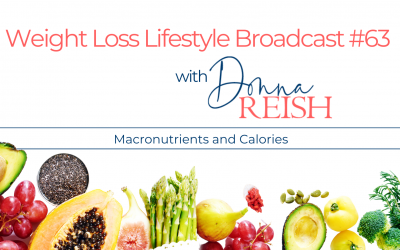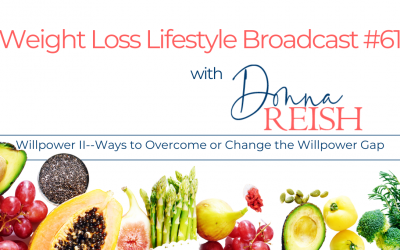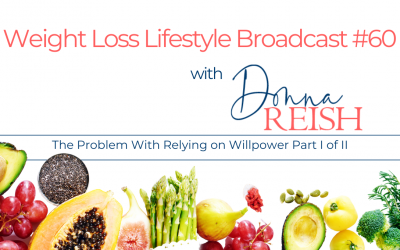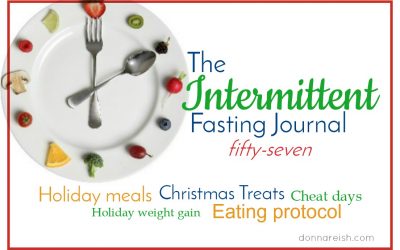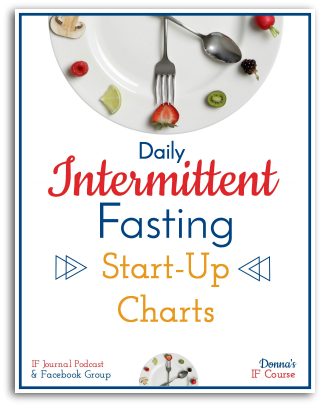
Weight Loss Lifestyle #63: Macronutrients and Calories
Hi! I’m Donna Reish, IF teacher, weight loss coach, blogger, and half of “The Minus 220 Pound Pair” as my husband and I have lost over 200 pounds together (160 of that in the past couple of years through the Perfect Storm of Weight Loss strategies I teach!).
In this episode, I present an explanation of Macronutrients and Calories.
Macronutrients, also called macros, are the three main nutrients that make up calories. That’s the important point—macronutrients make up calories. Every calorie in food is comprised of grams of carbohydrates, proteins, and fats.
One macro at a time, I explain the major elements and facts of each, how food is comprised of them, and why we need them.
The first Macronutrient Venn diagram gives a big picture of how each macronutrient stands alone and how they overlap with each other. The second Macronutrient Venn diagram gives a listing of food for each macro, including the foods that are known for having two of the macronutrients in them (such as carbs and proteins in beans and fat and protein in fattier meats).
I created this “lesson” for my weight loss clients and those following my “Perfect Storm of Weight Loss” as I realized that many people think of low carb as being completely separate from calories or low fat as being completely separate from calories—not realizing that calories are made up of fat, carbs, and protein.
Find all of my episodes, outlines, and articles for my two weekly broadcasts:
(1) Weight Loss Lifestyle broadcast (formerly Donna’s Intermittent Fasting Broadcast)
(2) Think-Feel-Eat broadcast at donnareish.com
Sign up for my free webinar: intermittentfastingwebinar.com
I want so many good things for you!
Weight Loss Lifestyle #63: Macronutrients and Calories
A. What Are Macronutrients?
1. Often called “macros” in the fitness world
2. Three main nutrients that make up our food
3. They are BIG, thus called Macros (as opposed to vitamins and minerals, which are called micronutrients)
4. They make up our entire caloric intake each day (unless you drink alcohol; that is another calorie source)
5. Mathematically, your entire calorie consumption in a day comes from these three macros combined
i. Thus, if you increase calories, you increase macros
ii. If you decrease calories, you decrease macros
iii. If you cut back on a macro and do not replace it with another macro, you have just cut back on total calories
B. Protein
1. FOUR calories per gram of protein, so good macro for calorie counters
2. Considered most satiating macro because it helps you feel full longer since it is slow to digest
3. Known to rev up metabolism by 15-30% after consuming it
4. Most easily recognized by hunger hormones
5. Protein’s negatives are that best sources come from meats (and organic is expensive); too much can cause kidney damage; some sources are super fatty, which increases calories and can be less heart healthy
6. Good percentage for many people for weight loss is 35% or approximately .75 grams of protein per pound of body weight
7. Builds muscle and is a core component in organs, bones, and most tissues
8. Made up of amino acids
9. Essential amino acids are necessary and not made by body—must be eaten
10. Two types
a. Complete—no need to combine it with anything else to get full protein from it (example, animal protein)
b. Incomplete—needs combined with something else to get full protein from it (example, beans and vegetarian sources of protein)
11. Fatty proteins are part protein and part fat (some animal protein, dairy, nuts, salmon, eggs, nut butter, seeds)
12. Lean proteins will be all protein (egg whites, chicken, turkey, not fatty fish and seafood, plant and whey proteins, lean meats)
13. Can raise blood sugar/cause an insulin spike but not to the extent that carbohydrates do
14. Studies have shown that people who eat 30% of their calories in protein consumed 441 fewer calories than those who did not—satiating, long lasting, metabolism revving!
C. Carbohydrates
1. FOUR calories per gram of carbohydrate so good macro for calorie counters
2. Most easily accessible source of energy
3. Largest insulin spike of the three macros
4. Least satiating macro since it is turned into glucose or glycogen quickly and used for immediate energy (exceptions are slow digesting carbs and fibrous carbs)
5. Negatives associated with carbs are that they spike insulin and keep you in sugar burning rather than fat burning; most processed foods and snacky foods are high in carbs so many people do not get their carbs from real foods; processed carbs are addictive (because they spike insulin/blood sugar all the time and because the pleasure receptors in the brain are very affected by them); people eat too many carbs and not enough of the other macros, especially protein.
6. Good percentage for many people for weight loss (especially those who have had trouble losing weight) is around 25%. (This would be approximately 100-120 carbs per day for a person consuming 2000 calories.)
7. Brain needs glucose and will get it first from carbs then the other macros
8. Processed carbs are least satiating of all macros—leave stomach quickly, used easily for energy, not filling
9. Fiber is a type of carb that is folded into the total carb count on a nutritional label
10. Low carb people often subtract the fiber from the carbohydrate total since fiber isn’t digested in the same way as other carbs and doesn’t “count” in terms of insulin spiking. (People who count both calories and macronutrients do not subtract fiber from their carb calories.)
11. Two main types of carbs
i. Simple—short molecule chain=easier to break down and use quickly=sugar
ii. Complex—long molecule chain=harder to break down=starch
D. Fat
1. NINE calories per gram of fat so not good macro for calorie counters (when only considering calories alone)
2. More satiating than carbs because they stay in the gut longer (ghrelin isn’t spiked as much since stomach has something in it for a while)
3. In terms of sheer calories, fat should be more satiating than the other two because they contain 2x (plus) the number of calories per gram than protein and carbs
4. Smallest insulin spike of all three macros
5. Negatives associated with fat are that people eat too many unhealthy fats that cause heart issues, blood pressure issues, etc.; that they are calorie heavy, so eating too many fat grams simply gives you too many calories for the day; people often eat trans fats in packaged foods (and the carbs in these lead to cravings)
6. The basis for the keto diet—75% carbs so keto people have to rely on fat bombs, butter on meat, cream and oil and butter in coffee, etc., for most of their calories
7. Trans fats are the worst fats to consume for heart health and are found in packaged foods
8. Fats are found with protein in fatty meats, dairy, nuts, eggs, salmon, chicken skin, nut butters, and seeds
9. Fats are found alone in butter, oils, avocados, and olives
10. Most important fats are fatty acids that the body doesn’t produce
i. Omega 3’s—from fatty fish
ii. Omega 6’s—from healthy oils
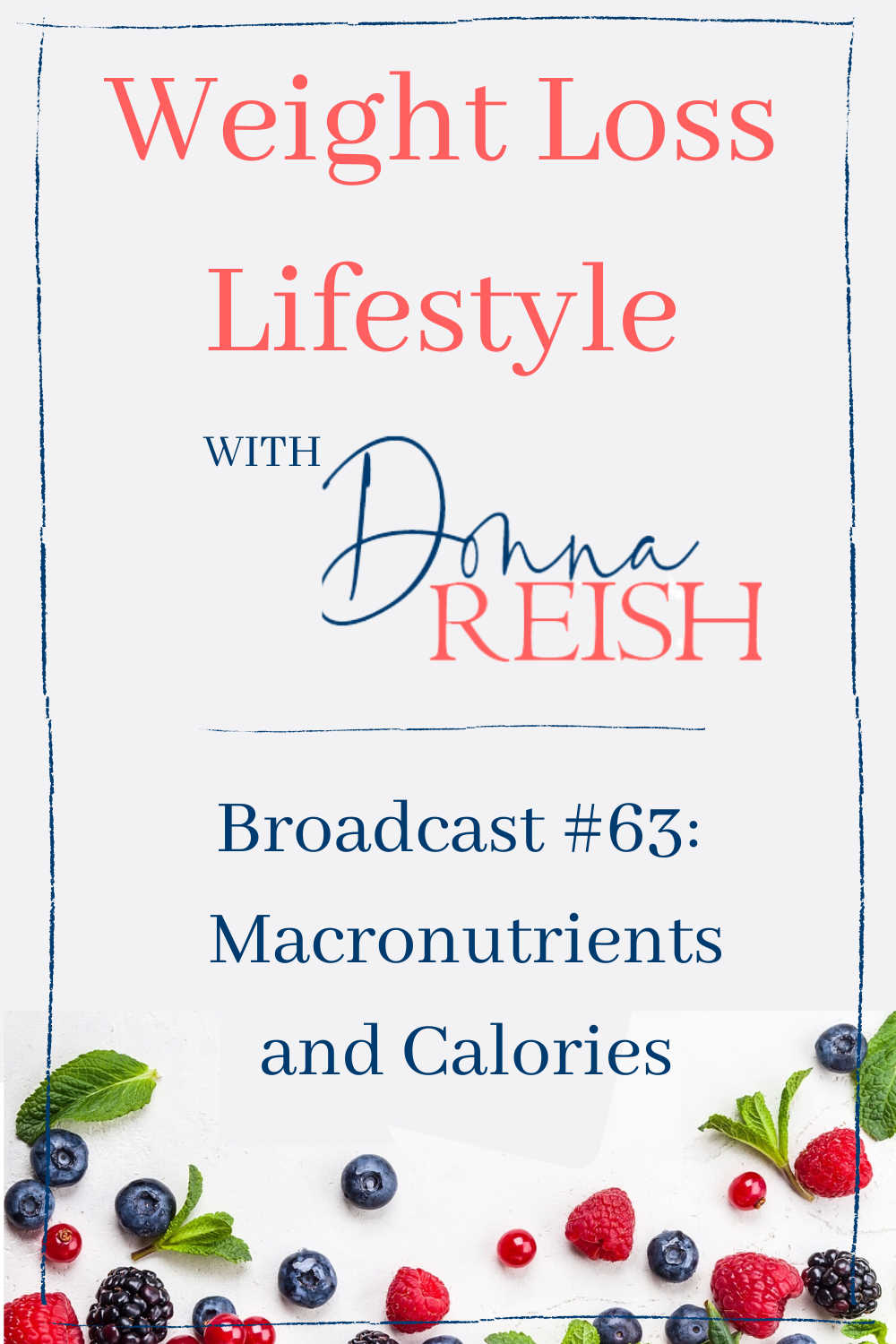
Weight Loss Lifestyle #62: Lessons From My 800th Fast (Part I)
Yay—my 800th fast!! This is gonna be festive!
In this episode, I share about how my 800th fast showed up on the Zero app, what I like about the app, and how to use an app to reach your fasting goals. Then I delve into how I average my fasts for the week—and the benefits and potential pitfalls of doing a weekly average.
I describe how for over two years my husband and I never went “off” and “on” but made IF a way of life. I also talk about what breaks my fast to me and signs to look for if you might be breaking your fast in a way that is not helpful to your overall goals.
Finally, I talk about what I have learned about the incredible benefits of Intermittent Fasting—its effects on hunger, whole meals, willpower, control, insulin/leptin, and much more!
Find all of my episodes, outlines, and articles for my two weekly broadcasts: (1) Weight Loss Lifestyle broadcast (formerly Donna’s Intermittent Fasting Broadcast) and (2) Think-Feel-Eat broadcast at donnareish.com Sign up for my free webinar: intermittentfastingwebinar.com
Check out the video, podcast, and outline below!
I want so many good things for you!
A. Zero App
1. Top part
a. 800 fasts!!!
b. 7 fast average time
c. Longest fast over all
d. Longest streak (misleading…must have pushed the wrong button!)
e. Current streak (misleading…must have pushed the wrong button!)
f. Never went off for 800 days…had a few 12-14 hour fasts for vacations and holidays; had many 14-16 hour fasts for weekend getaways, family events, etc.
2. Graph part
a. Daily hours
b. Average
c. Date
d. Goal reached colors each day (a little misleading if you are averaging)
Start fasting with my help! Use my FREE Intermittent Fasting Start Up Charts
B. Learned to Average
1. Never go off and on
2. Use high fasting days as compensation days not punishment days
3. Be careful of average when eating window is long (Decide ahead of time 2 or 3 instances with food, times, and amounts)
4. Averaging is not intended to create a binge or “pig out” day
5. Plan your eating instances even on longer eating window days (2-4 eating episodes decided ahead of time)
C. Learned What “Breaks” My Fast
1. “Eight Fasting Gurus on What Breaks the Fast” coming soon! All of them agree that fat in some form (even slight amounts of fat in cbd oil, etc.) are okay during the fast—I disagree as I say why consume anything you have to work through before you start burning body fat!
2. I’m not concerned with a little blip from communion or my 5 calorie supplement or toothpaste or sugar free mint if needed
3. Doctorate NP of Diabetes discusses insulin spikes and their effect and length
4. How I feel= broken fast to me
5. Cravings= broken fast to me
6. Hunger= broken fast to me
7. “Broken” might be for ten minutes then right back to fasting (but don’t use this as an excuse for “breaking” it as the little breaks add up—plus, the worst thing about “breaking a fast” is the ensuing hunger and cravings…don’t do it!)
Don’t miss an episode! Join the free private FB group to watch the Tuesday night Weight Loss Lifestyle broadcasts and the Thursday Think-Feel-Eat broadcasts right away!
D. Power of Fasting
1. Not affect weight LOSS as much as amount of food eating, cravings, hunger, dopamine spikes, willpower needs, control, etc.
2. Effect on hunger
3. Nibbles vs. whole meals
4. Willpower—need lessened and used in smaller time period
5. Control—says it all!
6. Insulin/leptin relationship
7. Puts me in good position to burn body fat (but not only way to lose weight or burn body fat)
Free webinar! https://intermittentfastingwebinar.com
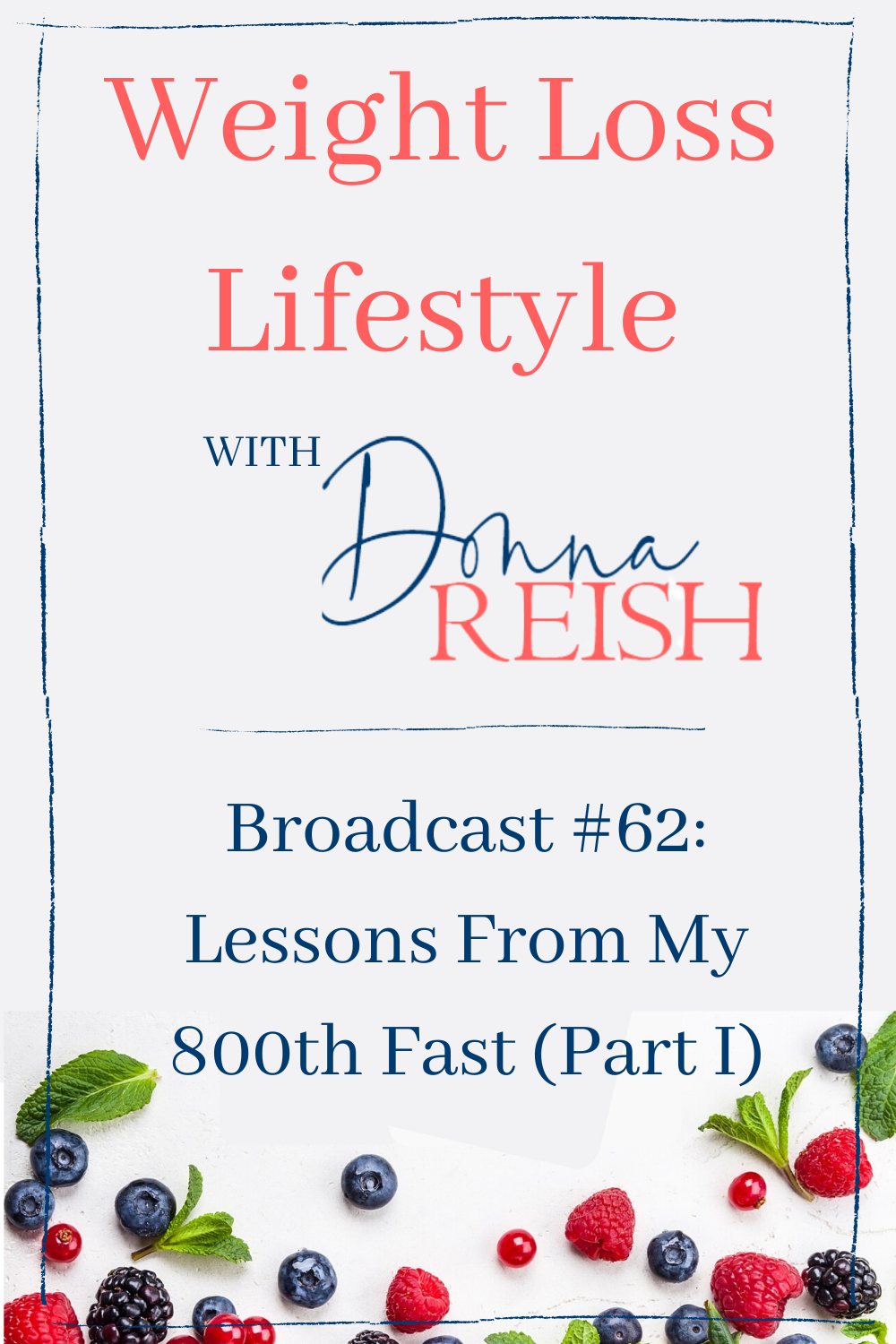
Weight Loss Lifestyle #61: Willpower II–Ways to Overcome or Change the Willpower Gap
In Episode #60, I explained that we have a willpower gap—a gap between the amount of willpower that we need each day and the length of day/number of temptations we are faced with each day.
We can do some things to manufacture more—we can refill some of our stores, we can do intentional self care tasks that give us more, and we can do daily lifestyle things that lead to a bump in willpower.
However, the best way to handle the willpower gap is to use what we have wisely, to reduce the need for so much of it, to control hormones to help us with the lack, and other “use wisely and reduce need” moves.
The first way to use our willpower more wisely is simply to “save it up” during Intermittent Fasting. Such a cool and simple trick to not use it for 119 food related decisions all day.
We also decrease our need for it overall in Intermittent Fasting as we help insulin, ghrelin, and leptin to work amazingly well for us–again through IF!
Next, we can actually NEED less willpower when we create automaticity in our lives! Yep…we can use “tiny habits” (Fogg) and “atomic habits” and “deciding ahead of time” (Castillo) to automatize much of our life!
And you know my love for all things Stephen Guyenet (Hungry Brain)! Finally, we can gradually reduce the extreme dopamine spikes that we get from such seductive, hyper-palatable foods over time (even with little choices)….and guess what? Less willpower will be needed!!
Outline , video, and podcast are below!
I want so many good things for you!
Part I: Review of Willpower
A. Willpower Review
1. What it is
a. Using internal strength to over-ride our brain to do something we don’t want to do or not do something we do want to do
b. Discovered in 1988 to be a “thing”
c. “Overriding a feeling in order to act in a way that is different than you feel like acting
2. All kinds of willpower are used each day adding up to overcoming 4 hours of temptations and 119 food-related decisions per day
B. Willpower needed for too many things each day–It takes willpower to resist (or sit with) over hunger and over desire
1. Over hunger—hunger signals, ghrelin telling us we are empty; leptin not telling us (or us not hearing it) that we are full
2. Over desire—processed foods, frequent eating, sugar and flour concentrations…all lead to overdesire due to neuro transmitters in the brain that tell us that we want more and more of those things each time we have them.
3. Willpower gap—running out of willpower before we run out of day/time/decisions that willpower is needed for.
Part II: Ways to Work With or Overcome Willpower Gap
A. Refill Willpower Stores
1. Ways we might be able to refill lagging willpower
a. Human connection—FB groups, people to text, like-minded people, etc.
b. Meditation—even quick sitting and taking 3 minutes of deep breathing
c. Prayer
d. Gratitude—MANY studies show that gratitude replenishes willpower! (Weekly gratitude list and reading it aloud each day)
e. Service—giving to others
f. Self Care
2. Self care
a. Deciding ahead of time is “adult self care”!
b. Don’t rely on immature/emergency self care—this will feel graspy and will not replenish like adult self care that you have decided ahead of time
c. Read, bath, music, instruments, hobbies, exercise
B. Intermittent Fasting
1. We do not have the willpower gap that we would have from the aforementioned 119 food decisions each day—no decisions at all for 16, 18, 19 hours!
2. We were never intended to …
a. Eat 7-12 times every 24 hours
b. Have such highly-processed, hyper-palatable foods
3. Our willpower is saved for during our eating window
4. Our insulin is kept low since we aren’t spiking it with food. This gives insulin a chance to drop and increase leptin/our ability to hear leptin and “hear the song of satiety” better.
5. When insulin is low, leptin is increased and heard better— we know when we are full more quickly and more thoroughly than eating all the time. We don’t need as much willpower to stop overeating when leptin is heard so clearly.
6. When we fast, we get control of the hunger hormone, ghrelin, so we actually train our body when to be hungry—so less willpower is needed! We are essentially overriding willpower during our fast through “clock hunger” and “ghrelin taming”!
7. Another benefit of leptin sensitivity (being able to hear leptin signals) is that we start to crave healthier foods—again, without willpower and white knuckling in order to eat those healthier foods.
8. Finally, fewer eating instances means fewer dopamine spikes. (See later in outline!)
C. Create Automaticity—Habits, Rituals, and Deciding Ahead of Time
1. Brushing our teeth
a. We brush out teeth with consistency—no sticky notes, timers, phone reminders, leaving things on the counter, charts, etc.!
b. We don’t rely on willpower to brush our teeth
c. We use automaticity, habits, rituals, and deciding ahead of time-as well as the clear desire to do it
d. We brush our teeth AUTOMATICALLY because we have a clear, unambiguous line that we will not cross—I will NEVER leave the house without having my teeth brushed!
e. We have a routine/ritual/automaticity in order for it to happen twice a day
2. We must automatize our eating so that it is more habitual, ritualistic, and automatic
a. Planning and preparing
i. As we plan and prepare, those plans turn into automatic actions and behaviors
ii. Then the plans become habitual and ritualistic
iii. “I got into the habit of”
iv. “I got out of the habit of”
b. Why losing 100 pounds over a decade has actually helped me—plenty of time to make my changes gradually and automatize them and get them to stick
3. Decide Ahead of Time
a. Studies showing we always PLAN to eat better ahead of time—the cake vs. fruit order
b. We always think we can do it when we are planning next week
c. Use this “decide ahead of time” strength to our benefit
d. Decide today WHEN you will eat tomorrow
e. Decide today WHAT you will eat tomorrow (watch for upcoming Protocol Planning broadcasts!)
f. Uses your pre-frontal cortex (adult brain) not toddler brain
g. Uses less willpower since it is decided when you are not in the heat of the moment
D. Reduce Six Seductive Craving Combinations So Dopamine Spikes Are Decreased
1. Dopamine is the habit/desire hormone that makes us want to eat junk food.
2. Every time we eat a processed food or drink a sugary drink, our dopamine is spiked, and we need more and more of those junk foods in order to be satisfied.
3. One way to decrease this over-desire is to decrease the number of eating opportunities
4. Eventually, with the help of leptin, lowered insulin, and grehlin, we will be able to decrease those spikes that need super human willpower to overcome.
5. Decrease one of the three major spikers: flour, sugar, fat…..
(Did you know that you can find all weekly broadcasts {Weight Loss Lifestyle/formerly Donna’s IF Journal} in one place at my website?)
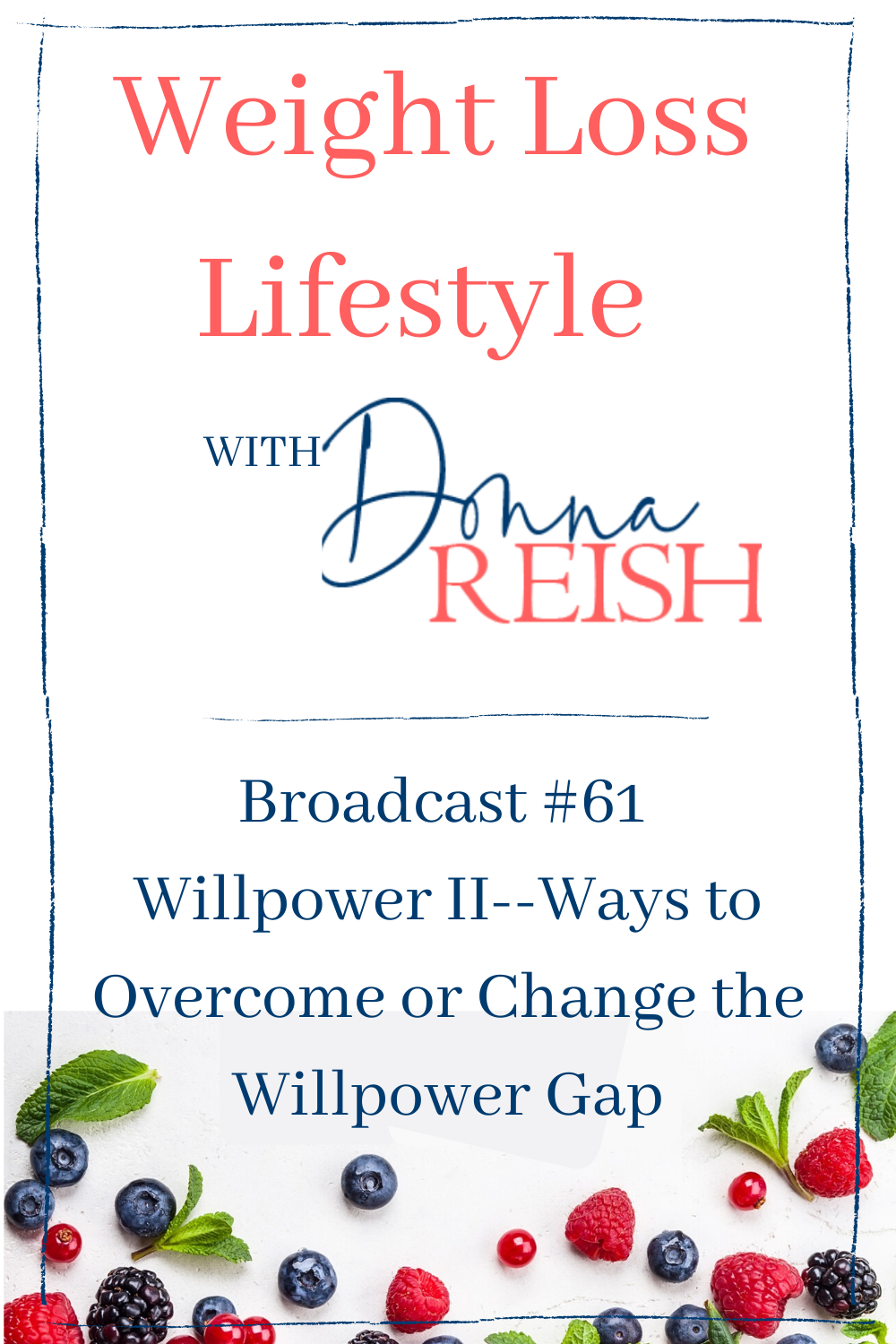
Broadcast #60 – The Problem With Relying on Willpower Part I of II
Why don’t I have more willpower?
Why can’t I just be stronger around food?
Why does food seem to control me?
These were questions that I have asked myself for over forty years!
So imagine my joy in discovering that the “lack of willpower” really wasn’t my fault…
And that research shows that trying to rely on it as our main means of controlling food urges simply doesn’t work.
So here is the scoop!!! It’s a long broadcast (and it’s only Part I of II!)…but if you are like I was…you NEED this info!
Like always, you can watch it at the blog below or on YouTube or just listen to it at the podcast! Easy peasy!
Also like always…detailed outline below…you need this info!
A. Relying on Will Power
1. How we rely on willpower
a. Making a plan, buying food, cleaning out, exercise program, etc. –1)
b. Relying on will power to keep plan in place
c. Leaves the weight of the changes on the part of the brain that is ill-equipped to make those decisions and carry the burden of saying no
2. What is willpower?
a. One definition: Overriding a feeling in order to act in a way that is different than you feel like acting
b. Discovered in 1988 to actually be a thing
3. Why we couldn’t conquer our food habits that made us obese with willpower
a. We used to wonder, like so many others, why we could have the self discipline and willpower to do things—raise children, work well in a job, create a nice home, develop habits and skills
b. But why couldn’t we (and so many people) apply those same self-regulating behaviors to lose weight and keep it off?
c. We didn’t know that the amount, type, and intensity of WILLPOWER needed to lose weight were nearly impossible to sustain when it comes to food urges.
B. Willpower Doesn’t Work Long Term (or Sometimes Even Short Term)
1) Radish experiment:
a. Come missing a meal
b. Chocolate chip cookies being piped in
c. Bowl of chocolate chip cookies and bowl of cleaned radishes
d. Told to eat in one of three ways
i. Couple of chocolate chip cookies (or just chocolate alone)
ii. A couple of radishes
iii. Nothing
e. Outcome
i. People who ate radishes, resisted cookies/chocolate could only do 8 minutes of puzzles
ii. People who were allowed to eat cookies could do 20 minutes of puzzles
f. Making decisions, monitoring emotions, keeping task performance high (few errors)
i. All of these things seem different but they’re all the same as resisting temptations
ii. They all need willpower; they all leave us in willpower depletion
2) Research with beepers
a) Beeped and asked over 400 people if they were resisting temptation at that moment or previous 15 minutes
b) Found that we spend four hours per day resisting temptations
3) Other experiments (M and M’s on table vs across the room—barriers!) and how much “brain power” they had left for intense tasks
4) Brian Wansink (researcher) has shown that we make 119 food-related decisions each day
C. We Have a Willpower Gap
1.Willpower gap means that we don’t have enough willpower left to overcome the urges that we are presented with
2.Willpower drains and depletes from all kinds of decisions and actions
4. It takes willpower to resist (or sit with) over hunger and over desire
a. Over hunger—hunger signals, grehlin tells us we are empty; leptin tells us we are full
b. Over desire—processed foods, frequent eating, sugar and flour concentrations, not real foods all lead to overdesire due to neuro transmitters in the brain that tell us we want more and more of those things each time we have them (dopamine and serotonin)
D. Ways We Handle Willpower Ineffectively
1. Eat many small meals and snacks
a. Research #1
i. Had morbidly obese people go on fixed calorie diet divided into either three meals a day or six meals a day
ii. No difference in weight loss
iii. No difference in health, adherence, etc.
b. Research #2
i. Closed chamber measuring carbon dioxide and oxygen
ii. Over three days people ate either three meals a day or six meals a day, completely standardized
iii. No difference in metabolism for three vs. six meals a day
c. Many small meals and snacks work against the body’s hormones
i. Insulin is kept high, so we don’t hear leptin signals tell us that we are full and need to move around
ii. Leptin is low when insulin is high
iii. We never give ourselves a chance to get hungry—so we become accustomed to not hearing grehlin tell us that we are full
2. “White knuckling” and “resisting” will get us through urges
a. Research, personal experience, and observations all show us this isn’t true
b. We simply run out of willpower to continue without intervening with our hormones, changing our thinking, and building habits (spoiler warning for next week!)
c. Like holding the beach ball under the water—eventually we have to release it
d. Not having enough willpower is also draining because of the shame and judgement we put upon ourselves when we run out of it and give in to urges
3. Eating whatever we want but counting will get us to our goals
a. Some people do need to count because they have no idea the huge amounts of food they are truly eating
b. But eating whatever we want and counting doesn’t work
i. Not enough “calories” for six times a day (“nibbles”)
ii. Eating highly palatable foods will spike dopamine repeatedly—this is why we can stop at one apple but we can’t stop at one cookie
iii. “Whatever we want” is so calorie dense that if we are counting, we will only be able to eat a few things a day—like one donut, one large shake, and a Big Mac take all the calories/fuel we have available for a day for most women!
E. Love to help others solve this critical weight loss mistake!
1. Some simple tweaks in when we eat, what we eat, and how many times we eat each day can completely change the brainpower/willpower issues!
2. Some simple tweaks in when we eat, what we eat, and how many times we eat each day can completely change the hormonal issues that keep us craving, over hungry, and giving in to urges!
3. I’d love to teach others how to practice Intermittent Fasting so we can help our brain and your body work FOR us rather than AGAINST us!
4. Sign up for my month-long Intermittent Fasting course—the first Monday of next month! https://intermittentfastingcourse.com
Broadcast #59 – Live Q and A From the Intermittent Fasting Course
Broadcast #59 is a Q and A….and I am excited to share it with you!
Just like all broadcasts, “it’s gonna be festive”!!!
It is actually a live Q and A from the Week Four of the January Intermittent Fasting Course….but the questions are so pertinent to all my readers and watchers that I thought I would make it into an official broadcast!
Speaking of the Intermittent Fasting Course, a new session begins tomorrow (February 3rd)….and a new one begins on the first Monday of each month! (Sign up tonight by midnight using the code SAVE20 to get $20 off!)
Back to the broadcast….here are the main questions I responded to:
1) Fasting for 23 or 24 hours each day–sustainable? eat anything? what does this mean???
2) OMAD (One Meal a Day) vs. OPAD (One Plate a Day) vs. an eating window with a meal and snacks/dessert
3) Appetite Correction–when, what contributes to it, how you will know
4) Stevia during the fast (Using three important markers: Wide, repeatable, consistent research; Personal Experience; Observation of Others
I want so many good things for you!!!
Intermittent Fasting Journal #58 Introducing the Self Coaching Model (The Think-Feel-Act Series)
Broadcast #58 is alive and well! And chock-full of valuable information for your weight loss journey–and for your life journey! Yep…I think it’s that impactful! In this broadcast, I introduce the first Thursday evening Model (recorded live in the FREE FB group every Thursday evenings!). The Self-Coaching Model, created by life coach Brooke Castillo, is a framework for chaning your life, understanding your thoughts and feelings, and taking the actions that you desire in your life. Tall order? Maybe….but watch and be amazed!
In this first episode of Thursday evening Models, I introduce the elements of The Model and apply them to several different circumstances to show you how The Model can be used in real life situations, thoughts, and feelings. I spend time to really give an understanding of the five elements of The Model: Circumstances, Thoughts, Feelings, Actions, and Results.
This material is life-changing, and many thanks are given to Brooke for her generosity in giving in to the world! And allowing weight loss coaches and others to share it with their readers and viewers!
As always…I have an outline below…but first…
The general model picture:

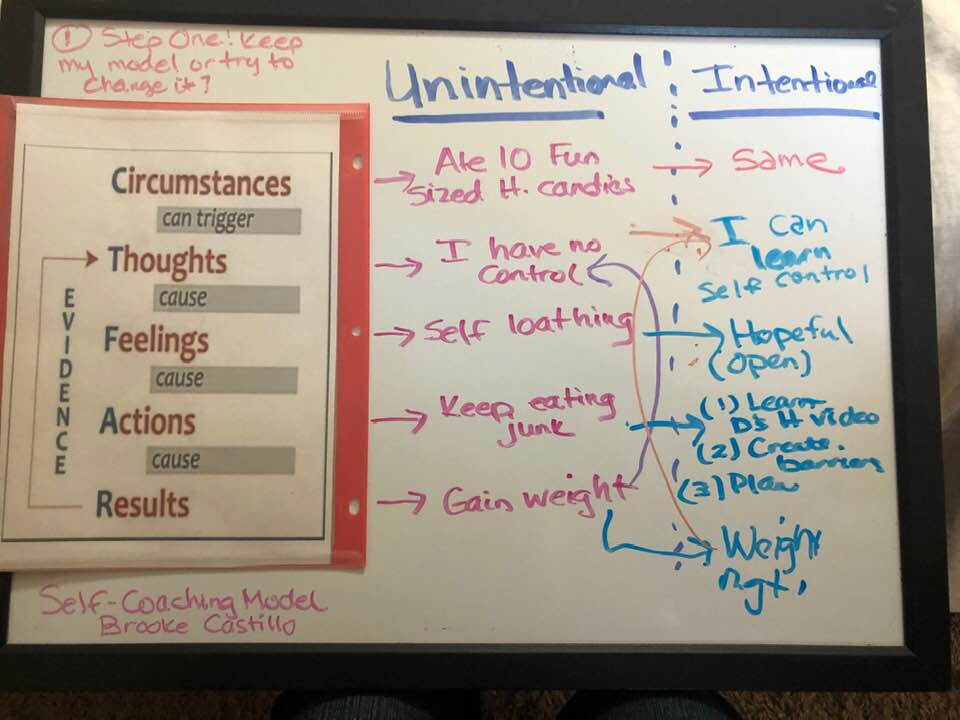
A. Pre-Requisites
1. Believe that life is 50% good and 50% bad—or some near combination of that
a. You don’t expect everything to be perfect
b. You are willing to accept the bad in life as needed
2. Believe in the components of the model for changing your life
a. C T F A R
b. Cee Totally FAR! (mnemonic)
c. See how they interact with each other

B. Understand the C Line First
1. Circumstances
a. Things that happen or that are that everyone believes happened
b. Can be proven in a court of law
c. No describers, disclaimers, trigger words, negative words, or positive words
d. Every single person you ask believes that that is a circumstance
2. When you think a thought is a circumstance
a. It is raining outside
i. No describers
ii. No thoughts about it
iii. Can be proven
iv. NOT: The rain is keeping people from having fun today
v. The rain is keeping people from having fun today is a thought—not everyone agrees with this
b. The traffic is stopped at the corner of Jefferson and Illinois
i. Traffic apps will say this
ii. The cars are stopped
iii. No describers
iv. Can be proven
v. NOT: The traffic is so bad
vi. Traffic is bad is a thought—not everyone agrees with this
c. Joe Smith died
i. Fact
ii. Obituary proves it
iii. No describers
iv. Not: It is sad that Joe Smith died
v. It is sad that Joe Smith died is a thought—not everyone agrees with this
C. Understand the Thought Line Next
1. Thoughts are sentences in your mind
2. They are your judgment or analysis or beliefs about something
3. We think they are circumstances—but they are not because they are in your brain and not everyone agrees with them
4. Thoughts drive everything
a. What we think about the rain
b. What we think about the stopped cars
c. What we think about Joe Smith’s death
5. Thoughts influence our feelings—and then our actions
6. When we have a thought that isn’t helping us reach our goals (goals like a better relationship, losing weight, growing our business, loving more, etc.), we can change our thoughts and this will help us change our feelings—and then our actions will follow!
D. Understand the Feeling Line Next
1. Feelings are vibrations in the body (not sensations like cold or hunger but how we would describe grief or joy or nervousness)
2. How we feel is based on what we think
a. If we think the rain is keeping us from having fun, we will feel a different way than if we think the weather is needed for the farmers
b. If we think the traffic is keeping us from our party, we will feel different than if we think the traffic means that someone else will have to clean the kitchen
c. If we think Joe Smith’s death is sad because we loved him, we will feel different than someone who wanted him to die on death row
E. Understand the Action Line
1. All of our actions stem from Thoughts-Feelings
2. If we want to change our lives, we will be very purposeful to change our thoughts and feelings (the basis of self coaching)
3. We act according to Thought and Feelings
a. If we feel sad about the weather, we will complain and bring the family down. If we feel okay about the weather, we will look for other fun options.
b. If we feel anxious about the traffic, we will worry about being late for work, scramble and make phone calls, try to reschedule meetings. If we feel glad about the traffic, we will text Hubby or daughter, have them clean the kitchen and listen to our favorite music in the traffic.
c. If we feel sad about Joe Smith’s death, we will seek comfort, cry, reach out, potentially eat our feelings, etc. If we feel glad about Joe Smith’s death, we will visit the execution and write about it, telling others that justice was served.
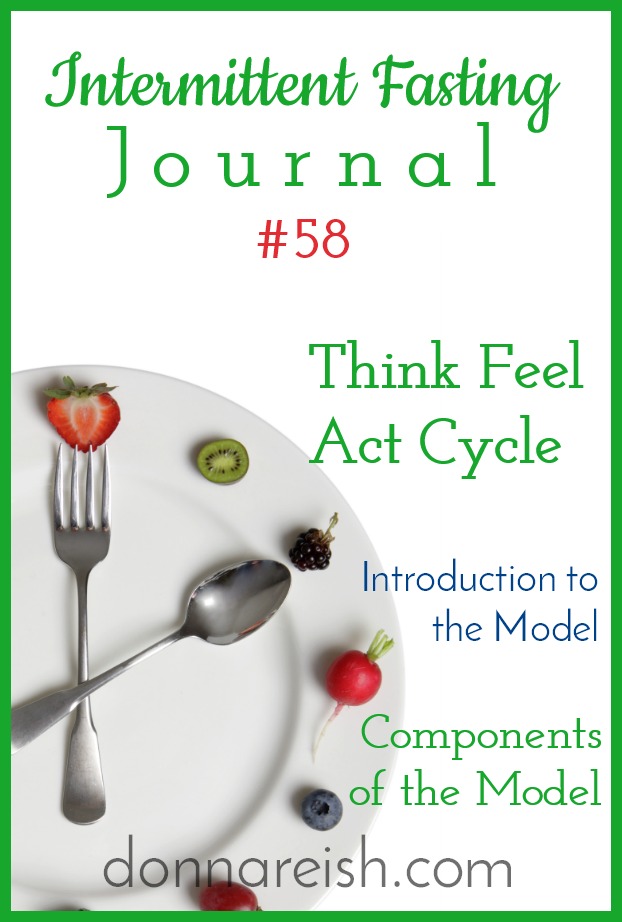
F. Understand the Results Line
1. Our results prove our thoughts
2. There is a direct correlation from Results to Thoughts
3. This is the basis of Positive Thinking and Law of Attraction—but without realizing that our Actions come into play too!
4. How our results prove our thoughts
a. If we listen to music and enjoy the traffic, we are proving the thought that someone else is cleaning the kitchen
b. If we complain about the weather and bring everyone down, we will not make other happy plans (or will do it half heartedly)
c. If we are at Joe Smith’s execution because we want to see justice served, we will have the result of thinking that he needed to be executed.
G. I Can’t Wait to Teach You to Apply This
1. Has changed so many things for me
a. Expectations of my husband and kids
b. How I view urges and weight management issues
c. How much I love
d. How much I judge
e. How I respond to criticism
f. How I work
2. Some future circumstances we will plug in
a. Three in-laws call me Donna
b. I ate 6 cookies last night
c. Someone said XXX and XX about me (quoted)
d. My kids visited one time in October
e. My weight has been 165 for four months
H. Free Content and Paid Services
1. Free video teaching weekly at Donna’s Weight Loss Lifestyle Facebook Group
2. Free hour long fasting webinar: https://intermittentfastingwebinar.com
3. Month-long Intermittent Fasting Course: https://intermittentfastingcourse.com
4. Weight loss coaching—email characterinklady@gmail.com
How Many Special Unhealthy Food Occasions Do You REALLY Have Between Halloween and New Year’s Day? (Broadcast #57)
The thing about me is I get a little crazy—just a little–when I learn something new or find something that works for me. (You didn’t know that already, did you? 🙂 )
And today’s Broadcast is no exception….
I have learned so much since I began weight loss coaching–and I want to shout it all from the mountaintops!
In this video (or podcast), I am sharing some of these new revelations, including:
1) How Deciding Ahead of Time is the key to weight loss and maintenance
2) Why Cheat Days cost us way more than we want to pay (and keep us from losing weight)
3) How to have a Fun Food exception episode each week to enjoy your very favorites–but not have cheat days that turn into cheat weeks!
4) How to figure up which meals or parties you will have Fun Foods (and which ones you really don’t need to)
5) How to THINK! The most important part of all!
I can’t wait for you to see the video! (Of course, I have a detailed outline for you–with all that math today, you might need it!)
Broadcast #57: How Many Special “Unhealthy” Food Occasions Do You REALLY Have Between Halloween and New Year’s Day?
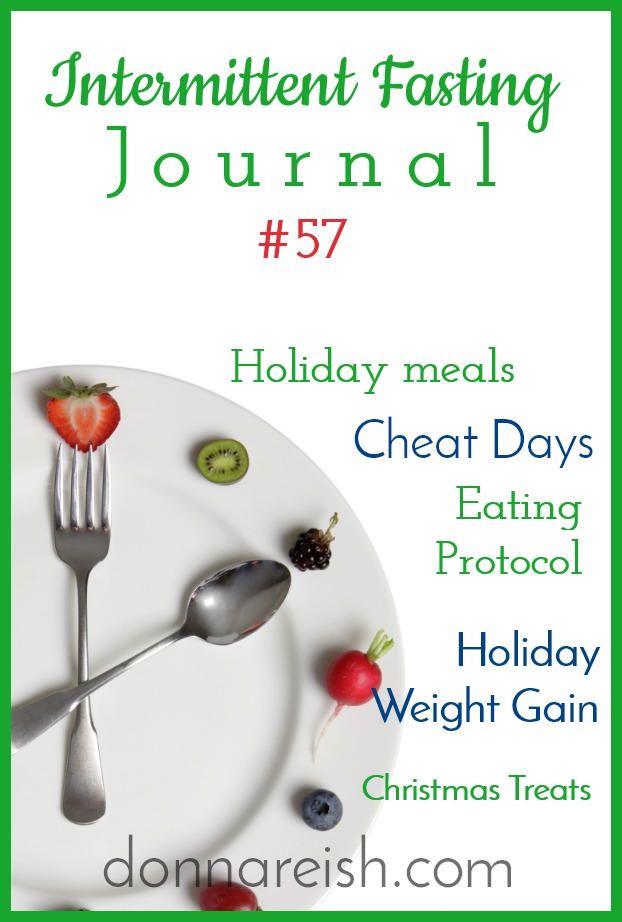
Make a weight management resolution that you will keep (unlike 92% of people who give up by January 25th!)….
You CAN practice Intermittent Fasting for the rest of your life! Use coupon code SAVE20 to get 20% off the January course session: https://intermittentfastingcourse.com
A. Throwing Healthy Eating Out the Window From Halloween to New Year’s Day
1. Average weight gain 7-12 pounds
2. People don’t start new eating protocols or they discontinue ones they are trying to implement
3. They wait until New Year’s resolutions—even though they have a 92% failure rate by January 20th!
B. Why and How to Combat This
1. They think it is because there are too many special occasions to even try
2. But are there really?
3. My mantra to my kids: “Every day is special, but every day isn’t a “special day”!
4. We want our kids to adopt this—you still have to go to school; you still have practice; you still have homework; you still have bedtimes, etc., but we don’t want to adopt it ourselves when it comes to food! #adulting
5. We create special days that do not really need to be exceptions and call every day an exception
6. “Cheat days”—exception days, off days, no count days, free days—whatever you want to call them keep us from our goal weight more than any other “mistake.”
7. They take us over the amount of food (calories for most people) that they need in a given week by adding an extra 2000 to 4000 calories on that day—so we never have a net loss
8. Exceptions should be one meal or one food one day a week or less off of the protocol you have chosen for yourself in order to sustain the loss you have already or have more weight loss (“Fun Food” meal!)
9. The concept of “I’m going off tonight anyway” and the overdrawn checking account—seriously! Why didn’t I see this for so many years????
C. It’s Simple Math
1. Simple to figure but harder to keep
2. Look at calendar from Halloween to New Year’s Day
a. Halloween–children’s holiday; we don’t need it “off” (save 4 to 6 pieces of your favorites and plan them ahead of time)
b. Church Thanksgiving dinner—how important is this to you? Can you make protocol food and eat that and save your “meal off” for family meal? Do you need three Thanksgiving dinners? Most of us do not.
c. Extended family Thanksgiving—Okay, I’ll give you this one because you only get Aunt Mary’s pie once a year (1 Fun Food Meal—1 total so far)
d. Immediate Family Thanksgiving—I’ll even give you this one—one MEAL, not the whole day (aghhh….who wants to feel that way for 12 hours??? Not me!) (1 Fun Food Meal—2 total so far)
e. School Christmas Program—Store bought cookies are NEVER worth it
f. Cookie Exchange Night—Unless someone baked your favorite cookie ON THE WAY to the exchange, nothing is fresh out of the oven, so just skip then (If you thought it was worth it while you were baking for it, that’s another matter—you might want to add that to your total depending on how many “specials” you have that week—remember there will be a lot of other baking coming up! Do not, I repeat, do not eat treats while baking AND at the event…you’re an adult…you can have more control than that!) Let’s have cookies today—but only warm, homemade, amazing ones, okay? (1 Fun Food Meal—3 total so far!)
g. Office Christmas Party—Decisions, decisions….I actually have a “worth it” list—maybe you need one too! Every eating out or party is really worth it. I have my top 20 or so that will always be worth it if my week doesn’t already have my “Fun Food Meal” in it. If the bread is amazing, maybe. If the desserts are truly homemade and are cake with cream cheese frosting…possibly. So let’s assume this is an amazing dinner at one of your favorite non-chain restaurants! Lol (1 Fun Food Meal—4 total so far!)
h. Church Christmas Program—Okay…you know those cookie exchange people are all bringing the leftover cookies to this, right? And you know that these programs happen all the time—VBS, summer, harvest, Christmas, spring….yeah….eat your intentional food before you go and help some young mommas with their littles!!
i. Extended Family Christmas—Alright…I’ll give you Aunt Mary’s Christmas Dessert…so go enjoy! (1 Fun Food Meal—5 total so far!)
j. Christmas Eve Eve Eve Eve Eve—Seriously?
k. Christmas Eve—Alright…one more meal (1 Fun Food Meal—6 total so far!)
l. Christmas Morning—You decide….two “Free Food Meals” in one day is a lot of unhealthy food, but you know if your traditions are worth it that day or not (1 Fun Food Meal—7 total so far!)
m. Christmas Dinner—Merry Christmas—but stop around 6 or so….and call it a day. You’ve had plenty. (1 Fun Food Meal—8 total so far!)
n. Day After Christmas—Stop the madness….send all leftovers home with someone and pour dish soap over the leftover pie and pitch it. (If you think it’s safe in the freezer, freeze some goodies for something in the future….if. it’s. safe.
o. New Year’s Eve—Celebrate! (1 Fun Food Meal—9 total so far!)
p. New Year’s Day—One meal..one meal only. Not a New Year’s Day brunch and dinner later…not a “last meal” before the diet tomorrow….one. fun. Food. Meal! (1 Fun Food Meal—10 total so far!)
D. Advanced Math
1. 60 days between Halloween and New Year’s Day
2. Perfectly on protocol 50 of those
3. Ten “special days”—one “fun food meal” per day
4. Potentially over by 1,000 calories on each of those days
5. Balanced out by some lower days and a little exercise and some great fasts…..
6. No weight gain!
E. Free Content and Paid Services
1. Free video teaching weekly at Donna’s Intermittent Fasting Group
2. Free hour long fasting webinar: https://intermittentfastingwebinar.com
3. Month-long Intermittent Fasting Course: https://intermittentfastingcourse.com
4. Weight loss coaching—email characterinklady@gmail.com
Love and hope,
Donna
P.S. Make a weight management resolution that you will keep (unlike 92% of people who give up by January 25th!)….join my January course!
You CAN practice Intermittent Fasting for the rest of your life! Use coupon code SAVE20 to get 20% off the January course session: https://intermittentfastingcourse.com
P.S.S. If you need one-on-one help, email me about my coaching services–I’m hanging out my shingle mid-January!
Intermittent Fasting Journal #56: How Much Do the Eating Window and Fasting Window Lengths Affect Weight Loss

Should you focus on the length of the fasting period or the food in the eating window for weight loss? Does longer always mean better weight loss? Should you eat differently if you have a short fast or a long fast?
Donna Reish, Intermittent Fasting teacher, blogger, weight loss coach, and curriuculum author, answers these and many other questions in this broadcast. She begins with the “Is IF magic” question.
Then she uses graphics to show four main ways we lose weight, inches, and cravings through IF.
Then she turns her attention to various fasting hours–and their effect on the foods and weight loss. These include 16:8; 18:6; 19:5; 20:4; 21:3; and more.
Follow along with the outline below! 🙂
A. Is IF Magic?
1. The magic of IF is in its ability to
a. Reduce insulin so reduce hunger and cravings
b. Control hunger by controlling hunger and satiety hormones
c. Helping us to lose inches as the body goes into fat burning mode during the fast
d. Keeping all of our food intake in a shortened period of time, which controls total food intake and non-fuel eating (and lets us eat more at one time, which most find more satisfying)
2. Four ways we lose weight, inches, and cravings through IF (see charts below)
B. 16:8
1. Might barely be into fat burning mode depending on food eaten day before
2. Super healthy way to live
3. Eight hours is usually too long to eat and cause a caloric deficit unless there are other parameters in place like two meals only or certain eating protocols
C. 18:6, 19:5
1. Usually enough time to be into fat burning mode, again, depending on what you ate the day before
2. Easily sustainable after the first three weeks or so (body adapts, clock hunger, etc.)
3. Can still overeat! Especially if grazing or not eating real foods
4. Leptin (satiety hormone) often doesn’t recognize drinks, processed foods, etc (this is why people who lost to goal on IF usually eat real foods or a real food protocol)
5. Can be two meals; one snack and one meal, etc. for weight loss
D. 20:4, 21:3
1. Longer fasting gives body a chance to be in fat burning better, but not mandatory
2. Harder to sustain
3. Many people call this OMAD—though most do not just eat one meal but often eat throughout the eating window or a snack, then dinner, then dessert
4. Many OMAD people do OMAD so they can eat whatever they want -but might still have trouble getting to goal (last 10-20 pounds) if eating processed foods/calorie dense foods during your OMAD, especially if not truly only doing one meal
E. Many factors to consider—
F. Join my Intermittent Fasting Course for November to get fasting strong before the holidays!
Broadcast #55: Make a Relationship Better by Tomorrow (Or…What Does Learning Pickle Ball Have to Do With Our Thoughts and Marital Harmony?)
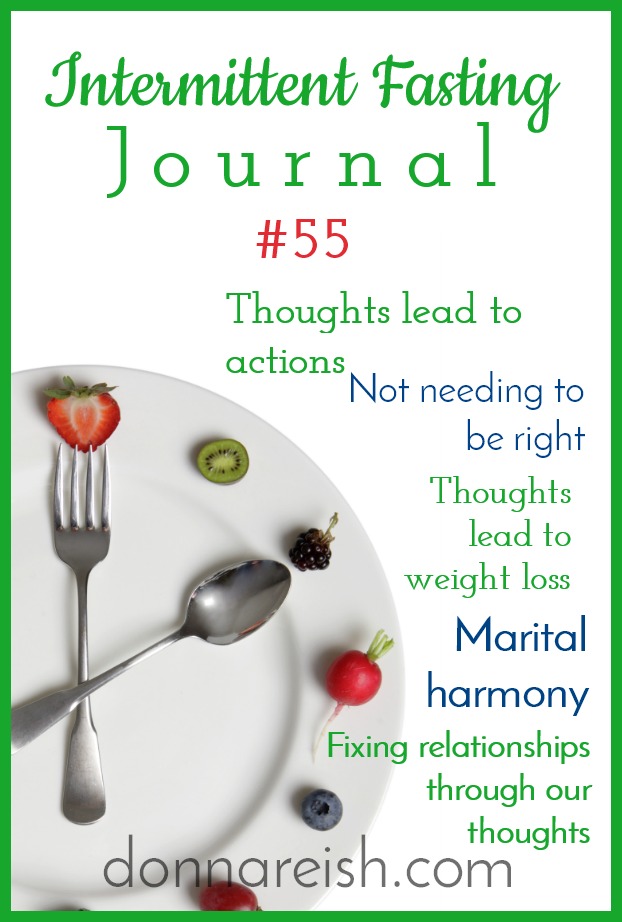
Are you getting tired of me telling you that you can control your thoughts–and that if you do control your thoughts, you will change the actions you take?
(Have you been following the thoughts and Emotional Eating five part series in the private FB group? Join and search Emotional Eating and the Model to see all the videos!)
Well….I hope you’re not too tired of it because I have a broadcast for you today that spells it out so clearly in a recent example in my marriage—our Pickle Ball Learning!
Yep…something as simple as learning pickle ball can cause us to think negative thoughts about people–and respond negatively to them!
Or we can control those thoughts and make the relationship better IMMEDIATELY!
How cool is that? That we have the power to make a relationship better by changing our thoughts?
I love this so much!
I have so much weight loss, fasting, fitness, cravings, and more to share with you…
But I am learning as I near the end of my weight loss and get ready to move into weight management—that so much of weight loss and weight management is truly in the mind.
Control the mind–and we will control the weight much better.
So let’s start today…with a pickle ball game…
And then we will carry it over to weight loss!
I have a thorough outline for you (you’re welcome—you know I love my outlines!). Enjoy–and think good thoughts!
A. Pickle Ball!
1. Watched Youtube videos
2. Ray Baby told me 543 times (okay, 543-500) how to do it while we played
3. Yet we still kissed every time we switched sides on the court!
B. Why?
1. Because our thoughts lead to our actions
2. Each time Ray Baby told me what to do, how to hold the racket, how to serve, and how to correct my mistakes, I was free to think anything I wanted…..
a. “Why does he keep telling me what to do? It’s not like he’s a Pickle Ball champ!”
b. “He is so helpful and kind. He always gives good advice. I love it that he wants me to improve so we can enjoy it more!”
3. What I thought each time he “coached” me would determine my actions next
a. Why does he keep telling me what to do—my actions would be anger towards him, discord, and unhappy game
b. He wants to help me so we enjoy it more—my actions would be kindness and gratefulness towards him; unity; and happy game.
C. Why Do I Have to Think These Thoughts If He Doesn’t Towards Me?
1. First of all, thankfully, we’ve been in this together long enough that he does too—we are both willing to think the thoughts and have the actions that lead to our marital joy
2. My kitchen instructions
3. What if he doesn’t do it too?
a. Does that make my thoughts and actions any different?
b. I have complete control over how I think, feel, and act in situations—and it isn’t based on what he does!
c. His thoughts and actions have no bearing on mine
D. You Can Be Right or You Can Be Happy
1. Doesn’t happy feel better than right?
2. Every time we do something petty (like respond negatively in pickle ball), we are making the choice to be right—and it never leads to happiness
a. Leads to drama
b. Leads to discord and disunity
c. Takes time to get back to where you were—and it wasn’t necessary at all!
3. Every time we do something like the “high road” (like respond positively in pickle ball), we are making the choice to be happy—but not right
a. Leads to unity
b. Leads to a continuation of love and joy in the relationship instead of going backwards over something that is absolutely not worth it!
E. We Were Taught This Forever
1. “Golden Rule”
2. “Put others before yourself”
3. “Think on these things”
4. “Take ever thought captive”
5. But for years I applied it to my life in terms of “the right thing to do”
a. It’s way more than the right thing to do
b. These thoughts and actions lead to true happiness and unity
c. These thoughts lead to a peace and harmony that you will never get “being right”
F. If Thoughts Lead to Actions…
1. We choose what we want to think
a. Stop saying “I can’t control it”
b. Start slowing down and purposely thinking a better thought
2. We think—then we act Period.
3. Thus, we can see our action (cold shoulder, animosity, fighting) and go backwards….
a. If we don’t like our actions, we must change our thoughts
b. Take the negative action and trace it back to the unhelpful thought
c. They are directly and fully linked
4. You can do this NOW! You can have a different relationship with someone tomorrow by thinking differently
a. Stop blaming
b. Stop trying to be right
c. Take 100% responsibility for the relationship—regardless of what the other person does
d. It might be hard…but it gives way more joy than the other options!
G. Learn More About “Good Thoughts Living”
1. https://donnareish.com
2. Donna’s Intermittent Fasting Group
Logical Fallacies (Broadcast #54)

In this broadcast, curriculum author, IF teacher, and former debat coach, helps listeners cut through the noise when it comes to claims, beliefs, and research about weight loss, macronutrients, and more. She begins by drawing on her experience as a high school debate teacher and coach to point out that the terms people are using must be defined in order for us to put them in context and see if they apply or not. Then she explains what logical fallacies and biases are–and how they apply to all people at all intellectual levels. Then she delves into the six common logical fallacies and biases with their definitions, explanations, applications, and what to look for with each one. These include anchoring bias, choice supportive bias, confirmation bias, ostrich bias, bandwagon effect, and false consensus effect. Her hope is that we will use three lenses to evaluate whether something works for us or not in applying what we hear and read:
(1) Personal Experience
(2) Outside Observations
(3) Robust, reliable research
A. Why I Want to Teach About Research and Thinking
1. Reading specialist masters work, language arts curriculum author, former high school debate coach, parent of seven adult kids whom we wanted to teach to THINK!
a. Teach levels of reading—literal, inferential, critical
b. Teach our kids not to believe everything they hear or read—to consider the source, experience, repeatability, logic, etc.
c. Teach our kids to be wary of people using the words never, ever, always, not, none, all, etc. (in our case, you will NEVER lose weight if you eat carbs or you will ALWAYS gain weight if you eat fat!)
2. Debate
a. Define terms—so many people do not do this when citing weight loss info
i. Calories in/Calories out doesn’t work (what doesn’t work about it?)
ii. We know insulin is all that matters ? (Matters for what?)
iii. We can see calorie restriction doesn’t work from the Biggest Loser study? (How doesn’t it work—-they lost weight, so it worked; if you mean they couldn’t sustain the protocol afterwards, then that part didn’t work)
b. Evidence from a credible source
i. Trained our debaters to point out right or left wing extreme publications
ii. Trained our debaters to point out sources that funded their own research for their stance
iii. Trained our debaters to point out sources that were “magazine-like” rather than true journal publications
3. Nutrition and politics!
a. Everybody has an opinion
b. Throw research around like it’s gospel regardless of source, date, repeatability, robustness, etc.
c. Confusing!
B. Why We Believe One Over the Other—Logical Fallacies and Biases
1. Who and what they appeal to
a. They appeal to the group and tell you that you are smarter (or make you feel that you are smarter—you and this whole group believes this, so it can’t be wrong!)
b. Appeal to the part of the brain that deals with emotion—the amegdela
c. They appeal to a primitive reaction (toddler brain)—making us feel smart
2. People who fall for logical fallacies and biases can be any intelligence level
a. Studies have shown that highly intelligent and less intelligent people fall for them equally (because of the part of the brain they appeal to—we all have that part of the brain working for emotional appeal, regardless of IQ)
b. Two race cars example
i. Can have two race cars—a beautiful, shiny. Fast,, new one and a clunker that hardly moves
ii. If both of them are turned off, the faster one still won’t “win”
iii. True with intelligence and logical fallacies—even someone who is extremely smart who is not thinking with their pre-frontal cortext but instead is being driven by emotion (amegdela), they still wouldn’t “win the race.”
C. Six Common Logical Fallacies and Biases
1.Anchoring Bias—Believing the first piece of evidence you receive
a. This is super compelling in weight loss/nutrition—-we learn something from one source then any source that disagrees with that first source is automatically wrong
b. Since you have that first piece of “evidence,” you feel smarter even when other opinions are presented
c. Example:
i. I used to attempt very low carb and some keto. When I branched out, I was biased against carbohydrates, saying things like “If you’re going to eat an apple, you might as well eat a Snickers bar. At least it has some protein too.”
ii. My bias was anchored on the first belief that all carbs are bad—even healthy ones.
d. Things to look for: Do you never change your mind with new data?
2.Choice Supportive Bias—can’t see drawback in your own position
e. Once we make a choice, we can’t be wrong
f. We feel smart with our original choice and do not want to admit we are wrong
g. We won’t believe any downsides in our original choice because it makes us look like we were wrong; another choice or future info can’t be right
h. Research and critical thinking
i. Even good research can’t convince us when we have that first “must be right” choice
j. Tip: Be just as critical about what you don’t believe as you are about what you do believe.
k. Example:
i. I believed and taught that you should open your eating window with low carbs to keep insulin low for the first part of your eating window.
ii. I didn’t want to see any downsides to this (satisfaction, too many calories, etc.) since I felt that my original choice was right and I had been teaching it.
iii. Hard for me to go back now and say just open with real food—-not overeating (i.e. too many calories) and not concerned with macros, even though I know this is a more satisfying and potentially less caloric way to open your window.
iv. (Note: Many people NEED to open their window with low carb foods to keep cravings lower, but I no longer teach it as universal as it doesn’t help everyone.)
k. Things to look out for: Can you list the problems with your position?
3.Confirmation Bias—looking for evidence that agrees with something we already believe
a. We look for articles, studies, blog posts, FB posts, etc. that agree with something that we already agree with
i. This forces us to exclude good research or conflicting information
ii. It also forces us to stay in our own shell and only listen to people whom we agree with
iii. Makes us feel smart to find things that agree with us
b. For instance
i. The only reason we read through a thread on social media is for your own pleasure
ii. No research—just the fact that it confirms your bias towards something
iii. Confirming our biases makes us feel smart
c. Example:
i. We believe insulin is all that matters in weight loss, so when we see a study about how thousands of people lost weight with calorie restriction, we won’t open it—-can’t be true anyway.
ii. We purposely only seek out what we agree with.
d. Things to look out for: Do you seek out information because it makes you feel good?
4. Ostrich Bias—ignoring negative research or contradictory info
a. Similar to confirmation bias
b. Decision to ignore negative info or research to the contrary
c. We ignore it entirely, sticking our heads in the sand
d. Example: I did this with Diet Coke—-wouldn’t read the info or research. Would delete articles people sent me.
e. Things to look out for:
i. Have you ever purposely looked for opposite research?
ii. Have you ever said, “There is no evidence for _____”
5. Bandwagon Effect—cultural…something is popular everywhere, so people believe it
a. Huge in social media
b. This is probably the biggest bias we face today because of social media—so easy to join a bandwagon and be confirmed in what we believe every hour on the hour!
c. Fads/popular/cultural
d. We must be smart because so many people believe this!
e. Example: Breakfast is the most important meal (adults only—children and teens have different nutrition needs)….so many joined this bandwagon!
f. Things to look out for:
i. Have there been longitudinal studies on your position?
ii. Is there a consensus in the scientific community or is it primarily pushed by influencers?
6. False Consensus Effect—your group has special knowledge and knows more than other groups
a. Within a bubble
i. One of the biggest ones for people in live groups and social media groups
ii.When we are immersed in a certain belief with people who have that same belief all the time, we think that’s how everyone thinks or that is how everyone should think.
iii. Similar dynamics to bandwagon except not as universal—more in a bubble of a group
b. Bandwagon vs. consensus—this is often counter popular (going against the culture)
c. This effect also feeds into our self esteem—because people agree with us.
d. Example:
i. I was in an exercise group that said that weights were bad for you. I agreed with them, said I could never do weights, said they were boring and ineffective, made jokes about the metal and the clunkiness of weight machines at the Y, etc. because I was under the false consensus effect.
ii. And the group continued to feed into that belief.
e. Things to look out for: Mocking, sarcasm, name calling, ad hominum attacks (impacting the person)

